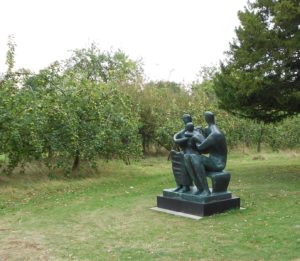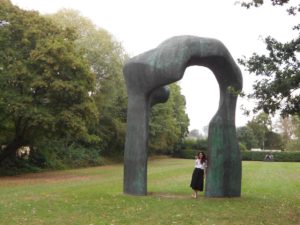13 October 2016
Time for Moore
The sculpture at Perry Green
by J.R.Thomas
 Regular readers will know that this column has a taste for anniversaries; preferably those overlooked but worthy of comment, rather than those vigorously commemorated for no particular reason other than marketing opportunities. This week it is our favourite type of event – a reason to remember a real talent, a chance to visit a source of inspiration and a rural crucible of beauty. And not least, it is being celebrated by the opening of a very fine café. Sometimes things just turn out to be perfect.
Regular readers will know that this column has a taste for anniversaries; preferably those overlooked but worthy of comment, rather than those vigorously commemorated for no particular reason other than marketing opportunities. This week it is our favourite type of event – a reason to remember a real talent, a chance to visit a source of inspiration and a rural crucible of beauty. And not least, it is being celebrated by the opening of a very fine café. Sometimes things just turn out to be perfect.
It is Henry Moore who we have cause to celebrate – thirty years since his death, but still the subject of international admiration, whose works speak just as inspiringly to us as they did to our grandparents when they were first astonished by his creations in the 1930’s and 40’s.
Moore was bombed out of his studio in Hampstead in 1940 and moved to Perry Green in Hertfordshire. It is a remarkably rural hamlet, only an hour from London (a considerably greater journey when Moore went there; the M11 has brought it closer, but without spoiling anything about it). Moore was famously a Yorkshireman, born in 1898, a miner’s son from the West Riding; he loved his home county and its Pennine Hills can be seen billowing through his works but, like a lot of Yorkshiremen, he left and never went back. Perry Green became the perfect background to his work, an ancient timber framed farmhouse, and behind it a selection of eccentric sheds. In another village this would be the residence of the village car bodger or hoarder. But no car bodger would have, amongst his sheds, the glory of Perry Green – a selection of Moore’s largest works, strewn across well mown lawns and hiding among the apple trees and climbing roses. There is no particular route or pattern to follow; just stroll and prepare your mind for jolting insights from astonishing sculpture. And do not neglect to look up to the hills – Moore was able to buy some fields beyond his garden which give this modestly rolling landscape a definitive and dramatic horizon. The fields are filled with sheep – and three huge dramatic products of Moore’s mind, counterpoints to the wooliness grazing amongst them, and yet, strangely akin.

Moore came to fame quite early in his career; he married Irina, a painter, in 1929 when he was already receiving significant commissions, his work often expressing inspiration from the female form. Irina and he finally had a daughter, Mary, in 1946 which brought dramatic changes to his work – his first large scale sculpture after the war was “Family Group” (on a school campus in Stevenage), and a series of family works followed, which brought him increasing public admiration. His work became on an increasingly monumental scale and several of these huge pieces were kept for his own and his visitors pleasure in the landscape of Perry Green. Those tatty sheds were where he was able to create on this scale, housing the whole process of creativity, starting from his drawings, now kept safe in a brooding new archives building. Other buildings house the maquettes, the plaster models, sometimes turned into small casts or carvings, that helped Moore visualise his final productions, and yet others his finished works, some of them test pieces for the large creations.
His output was prodigious. There are a large number of works in private and public collections in many parts of the western world, the largest single collection being in Toronto. Moore was a man uninterested in material rewards, his only extravagance being a house in Italy near the travertine marble quarries, and he retained always the socialist instincts of his youth. But his fame and workrate brought him great wealth – he was paying a million pounds a year in income tax in the early 1970’s – and to protect his personal collections from dispersal after his death he set up the Henry Moore Foundation, which now owns and presents Perry Green, and also the Henry Moore Institution based in Leeds which sponsors much research and new work.
Moore’s work has always a conundrum at its heart. On one level the pieces are simple, generous curving forms which give comfort through their generous shapes. Even people who profess grave dislike of modernist and abstract art usually find comfort in Moore pieces. On the other hand, they are a puzzle. They do not conform to expectations; walk round them and the viewer is confronted with something very different. Moore said that most people do not look at art; they glance and move on; nothing much is imbibed, the viewer has learned nothing. He wanted to create objects which would detain the observer, would cause them to think very profoundly. His great sculptures – and his small ones – have holes in them, jutting forms, wings that might just be hair blowing in a breeze; they might be human forms, family groups; but if they are of human forms then we have to accept that they are forms with distorted and eccentric proportions. The peace and trees of Perry Green, and the widely spaced pieces, gives space and time to brood.

If visiting Perry Green – and time is running out this year, it closes for the season on the 30th October – do not spend all your time thoughtfully contemplating the works outside; or even in the tea room. Leave lots of time to meander round those sheds; each one contains some aspect of Moore’s art and technique. The Yellow Brick Studio is an essential; if the ghost of Moore moves around Perry Green it is surely here that it spends most time. This was where Moore did his carving; releasing, as he put it, the hidden form from the block of marble. Carving is very hard physical labour; successful sculptors often prefer to design and supervise their works, leaving young fit juniors to do the noisy dusty repetitious work of chipping away at stone. But Moore did his own carving whenever he could; the very direct creativity of the labour meant a great deal to him. Another shed houses his maquettes, a great jumble of dreams contemplated and realised, the Plastic Studio housed large plaster casts, the Top Studio was his original working space at Perry Green, and the Etching Studio his drawing space, next to the family home, Hoglands.
But above all, visit the Aisled Barn, a great East Anglian wooden barn moved here late in Moore’s life to house a series of tapestries. They were a result of an introduction made by his daughter Mary Moore to West Dean College, set up by the rich surrealist Edward James (no greater contrast can be imagined than between the rich aesthete James and the coalminer’s son Moore) to preserve and encourage traditional craft techniques. Moore made drawings which were then woven in wool on a large scale. Hanging in the otherwise empty spaces of the barn they are powerful indeed; one of the most powerful being of showy figures sleeping on tube platforms during the London Blitz, evoking the horror and yet shared humanity of wartime experiences.
So here is a worthy anniversary indeed, a renewed excuse to view a range of emotions in wool, plaster, metal, and stone set in an intensely English landscape. Sit and stroll (and use that tea room), allow bronze and marble and paper and ink and plaster to seep into your soul. Do not be deflected by rain or bad light, they will give another perspective to your understanding. And remember kindly Moore’s father, also a carver, though of coal deep underground, wanting the best for his children, who objected to his son becoming a sculptor because, he said, he wanted to get him away from manual labour.
If you enjoyed this article please share it using the buttons above.
Please click here if you would like a weekly email on publication of the ShawSheet

